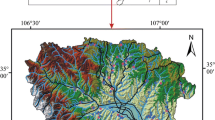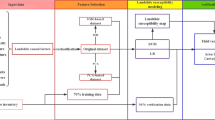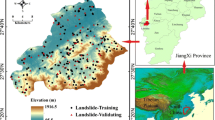Abstract
For the purpose of batter evaluating ground fissure susceptibility (GFS), this study developed a hybrid model based on factor optimization and support vector machines (SVM). Firstly, an evaluation index system of GFS was established containing 15 influence factors. Then, the data sample was normalized by certainty factors (CF) for the preparation of data analysis and machine learning. In the process of factor optimization, Schmidt orthogonalization (SO) was used to reduce collinearity in the data, and Pearson correlation coefficient (PCC) analysis was utilized to estimate its effect. Following, the principal component analysis (PCA) was applied to integrate and reduce the dimension of samples, and 9 component vectors were selected for the construction of SVM eventually. In the procedure of SVM modeling, the modeling data set was composed of 140 land fissure data and 140 non-deformation points. The cross-validation (CV) method was adopted to determine the required parameters, and the performance of the completed model was verified by statistical analysis and receiver operating characteristic (ROC) curve. The prediction accuracy of the final model reached a level of 0.852 with selected parameters. Finally, the GFS values of whole data in the study area were calculated by the trained model, and the GFS map was produced with its effect assessed. In conclusion, the model in this research can evaluate the GFS accurately and has a high value in both scientific research and engineering application.













Similar content being viewed by others
References
Adler J, Parmryd I (2010) Quantifying colocalization by correlation: the Pearson correlation coefficient is superior to the Mander’s overlap coefficient. Cytom Part A 77(8):733–742
Aleotti P, Chowdhury R (1999) Landslide hazard assessment: summary review and new perspectives. B Eng Geol Environ 58(1):21–44
Arabameri A, Chandra PS, Rezaie F, Chakrabortty R, Chowdhuri I, Blaschke T, Thi NPT (2021) Comparison of multi-criteria and artificial intelligence models for land-subsidence susceptibility zonation. J Environ Manage 284:112067
Arata Y, Gomi T, Sidle RC (2020) Topographic features and stratified soil characteristics of a hillslope with fissures formed by the 2016 Kumamoto earthquake. Geoderma 376:114547
Ayalew L, Yamagishi H, Reik G (2004) Ground cracks in Ethiopian Rift Valley: facts and uncertainties. Eng Geol 75(3):309–324
Baldi P, Hornik K (1989) Neural networks and principal component analysis: learning from examples without local minima. Neural Netw 2(1):53–58
Biber D (1988) Pearson correlation coefficients for all linguistic features. In: Biber D (ed) Variation across speech and writing. Cambridge University Press, Cambridge, UK, pp 270–279
Björck A (1967) Solving linear least squares problems by Gram-Schmidt orthogonalization. BIT 7(1):1–21
Björck A (1994) Numerics of Gram-Schmidt orthogonalization. Linear Algebra Appl 197–198:297–316
Boling JK (1988) Earth-fissure movements in south-central Arizona, U.S.A. MPhil Thesis. University of Arizona, Tucson, UA, USA
Boser BE, Guyon IM, Vapnik VN (1992) A training algorithm for optimal margin classifiers. Proceedings of the fifth annual workshop on computational learning theory. Pittsburgh, Pennsylvania, USA, pp 144–152
Chang CC, Lin CJ (2011) LIBSVM: a library for support vector machines. ACM Trans Intell Syst Technol 2(3):27
Chen W, Xie XS, Wang JL, Pradhan B, Hong HY, Bui DT, Duan Z, Ma JQ (2017) A comparative study of logistic model tree, random forest, and classification and regression tree models for spatial prediction of landslide susceptibility. CATENA 151:147–160
Chen XZ, Chen H, You Y, Liu JF (2015) Susceptibility assessment of debris flows using the analytic hierarchy process method-a case study in Subao river valley, China. J Rock Mech Geotech 7(4):404–410
Cheng YX, Zhang J, Peng JB (2013) ArcGIS-based evaluation of geo-hazards at Yaozhou County, Shaanxi, China. J Rock Mech Geotech 5(4):330–334
Cortes C, Vapnik VN (1995) Support-vector networks. Mach Learn 20(3):273–297
Galloway D, Jones DR, Ingebritsen, S (1999) Land subsidence in the United States. U.S. Geological Survey Circular, USGS Circ 1182:175
García MI, Mateos RM (2011) Sinkholes related to discontinuous pumping: susceptibility mapping based on geophysical studies. The case of Crestatx (Majorca, Spain). Environ Earth Sci 64(2):523–537
Gaur VP, Kar SK, Srivastava M (2015) Development of ground fissures: a case study from southern parts of Uttar Pradesh, India. J Geol Soc India 86(6):671–678
Geng DY, Li ZS (2000) Ground fissure hazards in USA and China. Acta Seismol Sin 13(4):466–476
Hanley JA, McNeil BJ (1982) The meaning and use of the area under a receiver operating characteristic (ROC) curve. Radiology 143(1):29–36
Hauksson E (1983) Episodic rifting and volcanism at Krafla in north Iceland: growth of large ground fissures along the plate boundary. J Geophys Res Sol Ea 88(B1):625–636
Hearn GJ (2019) Geomorphology in engineering geological mapping and modelling. B Eng Geol Environ 78(2):723–742
Heckerman D (1985) Probabilistic interpretation for MYCIN’s certainty factors. Proceedings of the first annual conference on uncertainty in artificial intelligence, Los Angeles, CA, USA, pp 167–196
Holzer TL (1989) State and local response to damaging land subsidence in United States urban areas. Eng Geol 27(1):449–466
Howard KWF, Zhou WF (2019) Overview of ground fissure research in China. Environ Earth Sci 78(3):97
Huang FM, Huang JS, Jiang SH, Zhou CB (2017) Landslide displacement prediction based on multivariate chaotic model and extreme learning machine. Eng Geol 218:173-186
Huang Y, Zhao L (2018) Review on landslide susceptibility mapping using support vector machines. CATENA 165:520–529
Jachens RC, Holzer TL (1982) Differential compaction mechanism for earth fissures near Casa Grande, Arizona. GSA Bull 93(10):998–1012
Janik P, Lobos T (2006) Automated classification of power-quality disturbances using SVM and RBF networks. IEEE T Power Deliver 21(3):1663–1669
Jeffreys H (1946) An invariant form for the prior probability in estimation problems. Philos Trans R Soc London Ser A Math Phys Sci 186(1007):453–461
Jia ZJ, Peng JB, Lu QZ, Meng LC, Meng ZJ, Qiao JW, Wang FY, Zhao JY (2020) Characteristics and genesis mechanism of ground fissures in Taiyuan Basin, northern China. Eng Geol 275:105783
Kavzoglu T, Kutlug SE, Colkesen I (2015) Selecting optimal conditioning factors in shallow translational landslide susceptibility mapping using genetic algorithm. Eng Geol 192:101–112
Kim JW, Lu Z, Jia YY, Shum CK (2015) Ground subsidence in Tucson, Arizona, monitored by time-series analysis using multi-sensor InSAR datasets from 1993 to 2011. ISPRS J Photogramm 107:126–141
Larson MK, Pewe TL (1986) Origin of land subsidence and earth fissuring, Northeast Phoenix, Arizona. Int J Rock Mech Min 23(6):215
Lee CF, Zhang JM, Zhang YX (1996) Evolution and origin of the ground fissures in Xi’an, China. Eng Geol 43(1):45–55
Leonard RJ (1929) An earth fissure in southern Arizona. J Geol 37(8):765–774
Li XD, Xi ZM (2013) Evaluation of deep groundwater exploitation degree in Hebei Plain. South-to-North Water Transf Water Sci Technol 11(6):129–132 (in Chinese)
Li YL, Yang JC, Hu XM (2000) Origin of ground fissures in the Shanxi Graben System, Northern China. Eng Geol 55(4):267–275
Liu NN, Feng XY, Huang QB, Fan W, Peng JB, Lu QZ, Liu WL (2019) Dynamic characteristics of a ground fissure site. Eng Geol 248:220–229
Liu NN, Huang QB, Wang L, Fan W, Jiang ZK, Peng JB (2018) Dynamic characteristics research of a ground fissure site at Xi’an, China. Tunn Undergr Sp Tech 82:182–190
Lofgren BE (1978) Hydraulic stresses cause ground movement and fissures, Picacho, Arizona. Geol Soc Am Bull 10(3):113
Metz CE (1978) Basic principles of ROC analysis. Semin Nucl Med 8(4):283–298
Minor HE (1925) Goose Creek oil field, Harris County, Texas. B Am Assoc Petrol Geol 9:286–297
Mohammady M, Pourghasemi HR, Amiri M (2019) Assessment of land subsidence susceptibility in Semnan plain (Iran): a comparison of support vector machine and weights of evidence data mining algorithms. Nat Hazards 99(2):951–971
Moore B (1981) Principal component analysis in linear systems: controllability, observability, and model reduction. IEEE T Automat Contr 26(1):17–32
Ozdemir A (2015) Investigation of sinkholes spatial distribution using the weights of evidence method and GIS in the vicinity of Karapinar (Konya, Turkey). Geomorphology 245:40–50
Peng JB, Chen LW, Huang QB, Men YM, Fan W, Yan JK (2013) Physical simulation of ground fissures triggered by underground fault activity. Eng Geol 155:19–30
Peng JB, Huang QB, Hu ZP, Wang MX, Li T, Men YM, Fan W (2017) A proposed solution to the ground fissure encountered in urban metro construction in Xi’an, China. Tunn Undergr Sp Tech 61:12–25
Peng JB, Qiao JW, Sun XH, Lu QZ, Zheng JG, Meng ZJ, Xu JS, Wang FY, Zhao JY (2020) Distribution and generative mechanisms of ground fissures in China. J Asian Earth Sci 191:104218
Peng JB, Sun XH, Wang W, Sun GC (2016) Characteristics of land subsidence, earth fissures and related disaster chain effects with respect to urban hazards in Xi’an, China. Environ Earth Sci 75(16):1190
Peng JB, Xu JS, Ma RY, Wang FY (2016b) Characteristics and mechanism of the Longyao ground fissure on North China Plain, China. Eng Geol 214:136–146
Peng MM, Lu Z, Zhao CY, Motagh M, Bai L, Conway BD, Chen HY (2022) Mapping land subsidence and aquifer system properties of the Willcox Basin, Arizona, from InSAR observations and independent component analysis. Remote Sens Environ 271:112894
Pratt WE, Johnson DW (1926) Local subsidence of the Goose Creek oil field. J Geol 34(7):577–590
Sandoral JP, Bartlett SR (1992) Land subsidence and earth fissuring on the Central Arizona project, Arizona. Int J Rock Mech Min 29(4):209
Seymour G (1974) A predictive approach to the random effect model. Biometrika 61(1):101–107
Shortliffe EH, Buchanan BG (1975) A model of inexact reasoning in medicine. Math Biosci 23(3):351–379
Sun DL, Wen HJ, Wang DZ, Xu JH (2020) A random forest model of landslide susceptibility mapping based on hyperparameter optimization using Bayes algorithm. Geomorphology 362:107201
Taheri K, Gutiérrez F, Mohseni H, Raeisi E, Taheri M (2015) Sinkhole susceptibility mapping using the analytical hierarchy process (AHP) and magnitude-frequency relationships: a case study in Hamadan province, Iran. Geomorphology 234:64–79
Vapnik VN (1998) Statistical learning theory. Wiley, New York, NY, USA
Vapnik VN, Chervonenkis A (1964) A note on one class of perceptrons. Automat Rem Contr+ 25
Wan JW, Li B, Tan CX, Feng CJ, Zhang P (2021) Formation mechanism of pumping-induced earth fissures associated with a pre-existing normal fault, Beijing, China. Eng Geol 294:106361
Wang FY, Peng JB, Meng ZJ, Qiao JW, Wen HG, Ma PH, Liu Y, Jia ZJ, Zhao JY (2019) The origin and impact of the Shizhuang ground fissure, Yingxian area, Datong Basin, China. Eng Geol 261:105283
Wang Y, Wen HJ, Sun DL, Li YC (2021) Quantitative assessment of landslide risk based on susceptibility mapping using random forest and GeoDetector. Remote Sens-Basel 13:2625
Wold S, Esbensen K, Geladi P (1987) Principal Component Analysis. Chemometr Intell Lab 2(1):37–52
Xu JS (2012) Study on the formation mechanism of ground fissures in North China Epicontinental Basin. PhD Thesis. Chang’an University, Xi’an, China (in Chinese)
Yao X, Tham LG, Dai FC (2008) Landslide susceptibility mapping based on support vector machine: a case study on natural slopes of Hong Kong, China. Geomorphology 101(4):572–582
Yin YP, Wang LQ, Zhang WG, Dai ZW (2022) Research on the collapse process of a thick-layer dangerous rock on the reservoir bank. B Eng Geol Environ 81(3):109
Yin YP, Zhang ZC, Zhang KJ (2005) Land subsidence and countermeasures for its prevention in China. Chin J Geol Hazard Control 16(2):1–8 (in Chinese)
Youssef AM, Al HHM, Gutiérrez F, Zabramwi YA, Bulkhi AB, Zahrani SA, Bahamil AM, Zahrani AJ, Otaibi ZA, El-Haddad BA (2016) Natural and human-induced sinkhole hazards in Saudi Arabia: distribution, investigation, causes and impacts. Hydrogeol J 24(3):625–644
Zhang KQ, Wang LQ, Dai ZW, Huang BL, Zhang ZH (2022a) Evolution trend of the Huangyanwo rock mass under the action of reservoir water fluctuation. Nat Hazards. https://doi.org/10.1007/s11069-022-05359-y
Zhang SH, Li ZH, Hou XN, Yi YJ (2019) Impacts on watershed-scale runoff and sediment yield resulting from synergetic changes in climate and vegetation. CATENA 179:129–138
Zhang WG, Zhang YM, Gu X, Wu CZ, Liang H (2022b) Application of soft computing, machine learning, deep learning and optimizations in geoengineering and geoscience. Springer, Singapore
Zhou GQ, Yan HB, Chen KH, Zhang RT (2016) Spatial analysis for susceptibility of second-time karst sinkholes: a case study of Jili Village in Guangxi, China. Comput Geosci-UK 89:144–160
Zhou XZ, Wen HJ, Zhang YL, Xu JH, Zhang WG (2021) Landslide susceptibility mapping using hybrid random forest with GeoDetector and RFE for factor optimization. Geosci Front 12(5):101211
Zhu AX, Miao YM, Yang L, Bai SB, Liu JZ, Hong HY (2018) Comparison of the presence-only method and presence-absence method in landslide susceptibility mapping. CATENA 171:222–233
Acknowledgements
The financial support is gratefully acknowledged. The authors also thank the editor and the anonymous reviewers for their insightful and constructive comments.
Funding
This work was funded by the China Geological Survey (No. DD20160267; No. DD20190317), the China Postdoctoral Science Foundation funded project (2021M700608) and the Natural Science Foundation of Chongqing, China (cstc2021jcyj-bsh0047).
Author information
Authors and Affiliations
Corresponding author
Ethics declarations
Competing interests
The authors declare no competing interests.
Rights and permissions
Springer Nature or its licensor holds exclusive rights to this article under a publishing agreement with the author(s) or other rightsholder(s); author self-archiving of the accepted manuscript version of this article is solely governed by the terms of such publishing agreement and applicable law.
About this article
Cite this article
Wang, X., Wang, L., Zhang, W. et al. Ground fissure susceptibility mapping based on factor optimization and support vector machines. Bull Eng Geol Environ 81, 341 (2022). https://doi.org/10.1007/s10064-022-02843-4
Received:
Accepted:
Published:
DOI: https://doi.org/10.1007/s10064-022-02843-4




